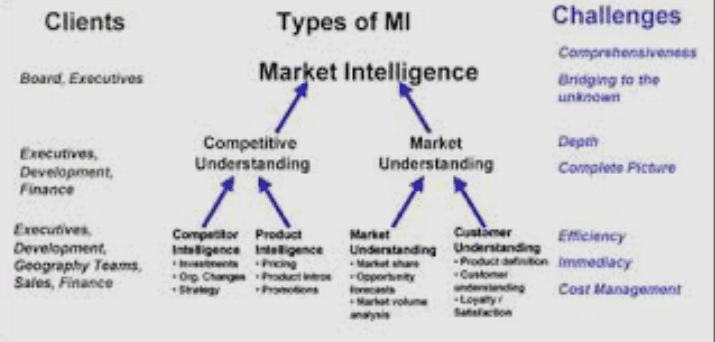Market intelligence is a crucial aspect of business strategy that involves gathering and analyzing information about the market, competition, and consumers to make informed decisions.
With the increasing competition and changing market dynamics, organizations need to stay abreast of the latest trends and developments to remain competitive.
Market intelligence involves collecting data from various sources, including competitors, customers, suppliers, and the broader market. This information is then analyzed to gain insights into market trends, consumer preferences, and competitive positioning.
The insights gathered through market intelligence can be used to identify potential opportunities, optimize pricing and product offerings, and enhance customer engagement.
One of the primary benefits of market intelligence is that it helps organizations stay ahead of the curve. By gathering information about emerging trends and changes in consumer behavior, businesses can identify new opportunities for growth and expansion.
For example, a company may discover a new market segment that is underserved and develop a product or service to meet their needs.
Market intelligence also helps organizations identify potential threats and challenges. By monitoring the competition and analyzing their strengths and weaknesses, businesses can develop strategies to stay ahead of the curve.
Additionally, by staying abreast of changing regulations and industry trends, businesses can adapt and adjust their strategies to stay compliant and competitive.
Another key benefit of market intelligence is that it helps businesses optimize their pricing strategies. By analyzing market trends, consumer behavior, and competitive pricing, organizations can develop pricing models that maximize revenue and profitability.
For example, a company may discover that lowering prices slightly can significantly increase sales volume, leading to higher overall profits.
Market intelligence also plays a critical role in product development. By analyzing consumer preferences and gathering feedback, organizations can develop products and services that better meet the needs of their target audience.
This can help businesses stay ahead of the competition by offering unique and innovative solutions.
Market intelligence helps organizations enhance customer engagement. By analyzing customer behavior and preferences, businesses can develop targeted marketing and advertising campaigns that resonate with their target audience.
Additionally, by gathering feedback and addressing customer concerns, businesses can improve customer satisfaction and loyalty.
Market intelligence is a critical aspect of business strategy that helps organizations stay competitive and profitable.
By gathering and analyzing information about the market, competition, and consumers, businesses can identify new opportunities for growth, optimize pricing and product offerings, and enhance customer engagement.
As the market continues to evolve and become increasingly competitive, market intelligence will become even more critical for businesses that want to succeed.
Read Also: Building a Strong Brand: Strategies and Tactics for Successful Brand Marketing
Competitive Intelligence

In today’s fast-paced business world, companies must be able to adapt quickly to changes in the market to remain competitive. One of the key components of this is having a solid understanding of the competition. This is where competitive intelligence comes in.
Competitive intelligence is the process of gathering and analyzing information about the competition to gain insights into their strategies, strengths, weaknesses, and potential moves. This information can then be used to make informed decisions and develop effective strategies that can give your company a competitive advantage.
The Importance of Competitive Intelligence
In the highly competitive world of business, staying ahead of the competition is crucial. By gathering and analyzing information about the competition, companies can identify potential threats, spot trends, and capitalize on opportunities. Competitive intelligence can help companies:
Anticipate Competitor Moves: By analyzing the competition’s behavior, companies can anticipate their moves and be better prepared to respond. This includes predicting product launches, market entries, or changes in strategy. This can help companies respond quickly, avoid surprises, and protect their market share.
Identify Market Trends: Competitive intelligence can also help companies identify market trends and emerging technologies. By staying ahead of the curve, companies can develop products and services that meet changing consumer demands, giving them a competitive edge in the marketplace.
Develop Effective Strategies: By understanding the competition’s strengths and weaknesses, companies can develop effective strategies that exploit their competitors’ weaknesses while capitalizing on their own strengths.
This can help companies differentiate themselves in the market and build a loyal customer base.
Stay Ahead of the Curve: competitive intelligence can help companies stay ahead of the curve and outpace the competition. By constantly monitoring the competition, companies can stay on top of industry developments, refine their strategies, and remain relevant in an ever-changing market.
How to Conduct Competitive Intelligence: The process of conducting competitive intelligence can vary depending on the company and the industry. However, there are some general steps that can be followed:
Identify the competition: Start by identifying the key players in your industry.
Gather information: Collect information about the competition from a variety of sources, including their website, social media accounts, news articles, industry reports, and customer reviews.
Analyze the data: Analyze the data to identify the competition’s strengths, weaknesses, opportunities, and threats.
Develop strategies: Develop strategies that take advantage of the competition’s weaknesses while capitalizing on your own strengths.
Implement and monitor: Implement your strategies and monitor the competition’s behavior to identify any changes that could impact your business.
In today’s fast-paced business world, competitive intelligence is a critical component of success. By understanding the competition, companies can make informed decisions, develop effective strategies, and stay ahead of the curve.
Whether you’re just starting out or looking to stay ahead of the competition, competitive intelligence is a powerful tool that can help you achieve your goals and gain a strategic advantage.
Read Also: The Power of Inbound Marketing: How to Attract, Engage, and Delight Your Target Audience
Market Analysis Tool
Market analysis is a crucial tool for businesses of all sizes and industries. It involves the systematic gathering and interpretation of information about market conditions, customer needs and preferences, industry trends, and competitive dynamics.
The goal of market analysis is to provide businesses with the insights they need to make informed decisions about their products, services, marketing strategies, and overall business plans.
In this article, we will explore the key components of market analysis and how businesses can use them to gain a competitive edge in the marketplace.
The Components of Market Analysis
Market analysis typically involves four key components: market size and segmentation, market trends, customer analysis, and competitor analysis.
Market Size and Segmentation: Market size refers to the total demand for a particular product or service in a given geographic area.
It is important to understand the size of the market in order to estimate the potential demand for a product or service and the size of the opportunity. Market segmentation involves dividing the total market into smaller groups of consumers who have similar needs or characteristics.
This allows businesses to tailor their products and marketing strategies to specific segments and maximize their impact.
Market Trends: Market trends refer to the changes and developments that are occurring within the industry, such as new technologies, emerging consumer preferences, or shifts in the competitive landscape.
It is important to stay up to date on market trends in order to identify potential opportunities or threats to a business and adapt their strategies accordingly.
Customer Analysis: Customer analysis involves understanding the needs, preferences, and behavior of the target customer group. This includes factors such as demographics, psychographics, and buying habits.
By understanding the target customer, businesses can develop products and marketing strategies that are tailored to their specific needs and increase their chances of success.
Competitor Analysis: Competitor analysis involves identifying and analyzing the strengths and weaknesses of the competition.
This includes understanding their products, marketing strategies, pricing, and distribution channels. By understanding the competition, businesses can develop strategies to differentiate themselves and gain a competitive advantage.
How to Conduct Market Analysis
Market analysis can be conducted using a variety of methods, including surveys, focus groups, market research reports, and industry publications.
Here are some steps businesses can follow to conduct effective market analysis:
Define the research objectives and scope of the analysis.
Gather relevant data and information from a variety of sources.
Analyze the data to identify key trends, opportunities, and challenges.
Develop insights and recommendations based on the analysis.
Monitor and evaluate the effectiveness of the strategies and adjust as needed.
Benefits of Market Analysis
Market analysis provides businesses with a range of benefits, including:
Improved decision making: Market analysis provides businesses with the information they need to make informed decisions about their products, services, and marketing strategies.
Reduced risk: By understanding the market conditions and customer preferences, businesses can reduce the risk of launching products or services that do not meet the needs of the market.
Competitive advantage: Market analysis allows businesses to identify opportunities to differentiate themselves from the competition and gain a competitive edge in the marketplace.
Increased customer satisfaction: By understanding the needs and preferences of the target customer, businesses can develop products and services that meet their needs and increase customer satisfaction.
Market analysis is a critical tool for businesses of all sizes and industries. By gathering and interpreting information about market conditions, customer needs and preferences, industry trends, and competitive dynamics, businesses can make informed decisions and gain a competitive edge in the marketplace.
